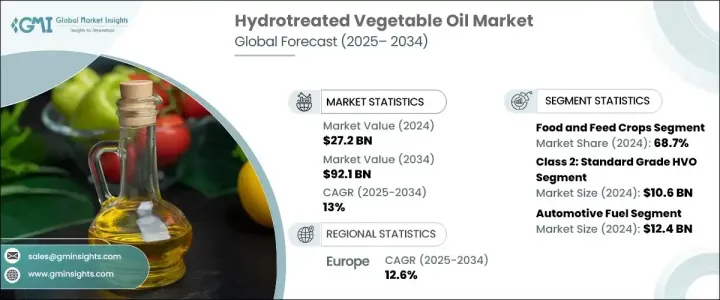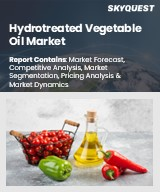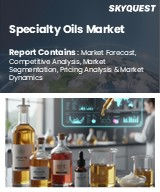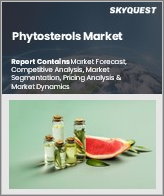
|
시장보고서
상품코드
1716722
세계의 수소화 처리 식물성 기름(HVO) 시장 : 기회, 성장 촉진요인, 산업 동향 분석, 예측(2025-2034년)Hydrotreated Vegetable Oil Market Opportunity, Growth Drivers, Industry Trend Analysis, and Forecast 2025 - 2034 |
||||||
세계의 수소화 처리 식물성 기름(HVO) 시장은 2024년 272억 달러에 달했고, 2025년부터 2034년까지 연평균 복합 성장률(CAGR) 13%로 확대될 것으로 예측됩니다.
신재생에너지원으로의 변화가 높아짐에 따라 HVO는 산업계 전체에서 지속가능한 대체연료로서의 역할을 급속히 높여 가고 있습니다. HVO는 기존 디젤연료의 드롭인 대체연료로서 기능하여 보다 깨끗한 연소와 온실가스 배출량을 줄이기 때문에 운수, 항공, 산업용 발전 등 주요 섹터에서 수요가 높아지고 있습니다.

특히 북미와 유럽의 일부 정부는 HVO의 사용을 직접 장려하는 세액공제, 혼합연료의 의무화, 배출범위 설정 등의 정책 틀로 탄소배출 감축의 의무화를 강화하고 있습니다. 관민 투자 증가는 비용 경쟁력을 유지하면서 HVO 생산을 확대하는 혁신적인 방법을 공개 회사가 모색하는 가운데 시장 전망을 더욱 강화하고 있습니다. ESG 목표 달성을 목표로 하는 산업이 늘고 있는 가운데 HVO와 같은 깨끗하고 저탄소 대체연료에 대한 주목은 점점 높아지고 있으며, 선진 경제국가와 신흥경제국 모두에서 급속한 보급이 진행되고 있습니다.
| 시장 범위 | |
|---|---|
| 시작 연도 | 2024년 |
| 예측 연도 | 2025-2034년 |
| 시작 금액 | 272억 달러 |
| 예측 금액 | 921억 달러 |
| CAGR | 13% |
2024년에는 식품 및 사료용 작물 분야가 68.7%의 점유율로 HVO 시장을 독점했으며, 2034년까지의 CAGR은 12.4%를 보일 것으로 예측됩니다. 유채와 같은 작물은 효율적인 HVO 생산에 필요한 오일공급에 있어서 매우 중요하며, 증대하는 바이오연료 수요를 충족시키기 위한 안정된 원료공급을 보장하고 있습니다.
시장은 등급별로 구분되며, 프리미엄 등급, 표준 등급, 기본 등급, 스페셜티 등급이 있습니다. 표준 등급은 비용, 성능, 범용성의 균형에서 점점 선호되고 있으며, 운송, 산업 운영, 발전에 이상적인 선택이 되고 있습니다.
지역별로 유럽의 수소화 처리 식물성 기름(HVO) 시장은 2024년에 103억 달러에 이르렀으며, 2034년까지 연평균 복합 성장률(CAGR)은 12.6%로 예측되고 있습니다. 유럽 연합의 RED II 지침과 바이오연료 혼합 의무화 증가는 HVO의 통합을 크게 가속화하고 유럽을 저탄소 에너지로 전환하기 위한 세계적인 노력의 최전선에 위치하고 있습니다.
목차
제1장 조사 방법과 조사 범위
제2장 주요 요약
제3장 업계 인사이트
- 생태계 분석
- 밸류체인에 영향을 주는 요인
- 이익률 분석
- 혁신
- 장래의 전망
- 제조업체
- 유통업체
- 공급자의 상황
- 이익률 분석
- 주요 뉴스와 대처
- 규제 상황
- 영향요인
- 성장 촉진요인
- HVO 생산 기술의 진보
- 신재생에너지에 대한 수요 증가
- 자동차 섹터에서의 수요 증가
- 업계의 잠재적 위험 및 과제
- 높은 생산 비용
- 다른 재생 가능 연료와의 경쟁
- 성장 촉진요인
- 성장 가능성 분석
- Porter's Five Forces 분석
- PESTEL 분석
제4장 경쟁 구도
- 소개
- 기업 점유율 분석
- 경쟁 포지셔닝 매트릭스
- 전략 전망 매트릭스
제5장 시장 규모와 예측 : 원료 공급원별, 2021-2034년
- 주요 동향
- 식품 및 사료용 작물
- 대두유
- 카놀라유
- 해바라기 기름
- 팜유
- 기타
- 동물성 유지
- 수지
- 라드
- 사용한 식용유
- 팜유 공장 폐액
- 기타
제6장 시장 규모와 예측 : 등급별, 2021-2034년
- 주요 동향
- 클래스 1: 프리미엄 등급 HVO
- 클래스 2: 스탠다드 등급 HVO
- 클래스 3: 기본 등급 HVO
- 클래스 4: 스페셜티 등급 HVO
제7장 시장 규모와 예측 : 기술별, 2021-2034년
- 주요 동향
- 독립형 수소화 처리 기술
- 코프로세싱 기술
제8장 시장 규모와 예측 : 용도별, 2021-2034년
- 주요 동향
- 지속 가능한 항공 연료
- 자동차 연료
- 선박용 연료
- 산업용 발전 연료
- 난방용 연료
- 농업기계연료
- 윤활유
제9장 시장 추계·예측 : 지역별, 2021-2034년
- 주요 동향
- 북미
- 미국
- 캐나다
- 유럽
- 독일
- 영국
- 프랑스
- 스페인
- 이탈리아
- 네덜란드
- 아시아태평양
- 중국
- 인도
- 일본
- 호주
- 한국
- 라틴아메리카
- 브라질
- 멕시코
- 중동 및 아프리카
- 사우디아라비아
- 남아프리카
- 아랍에미리트(UAE)
제10장 기업 프로파일
- ALFA LAVAL
- Cepsa
- Desmet
- DIAMOND GREEN DIESEL
- Neste
- Preem
- Repsol
- Shell
- TotalEnergies
- UPM Biofuels
- Valero Energy
- World Energy
The Global Hydrotreated Vegetable Oil Market reached USD 27.2 billion in 2024 and is projected to expand at a CAGR of 13% between 2025 and 2034. The growing shift toward renewable energy sources is rapidly elevating HVO's role as a sustainable fuel alternative across industries. As global economies pivot to reducing dependence on fossil fuels, HVO is emerging as a critical solution for meeting decarbonization goals. Its ability to serve as a drop-in replacement for traditional diesel, combined with cleaner combustion and lower greenhouse gas emissions, is pushing demand among major sectors, including transportation, aviation, and industrial power generation.

Several governments, particularly in North America and Europe, are stepping up mandates to cut carbon emissions with policy frameworks like tax credits, blending mandates, and emission caps that directly encourage the use of HVO. These policies are opening new growth opportunities for HVO producers and reinforcing their importance in the global shift toward greener energy. Increasing public and private investments in advanced biofuels and next-generation feedstocks are further enhancing the market outlook as companies explore innovative ways to scale HVO production while keeping costs competitive. As more industries seek to meet ESG (Environmental, Social, and Governance) goals, the focus on clean-burning, low-carbon alternatives like HVO continues to intensify, fueling rapid adoption across both developed and emerging economies.
| Market Scope | |
|---|---|
| Start Year | 2024 |
| Forecast Year | 2025-2034 |
| Start Value | $27.2 Billion |
| Forecast Value | $92.1 Billion |
| CAGR | 13% |
In 2024, the food and feed crops segment dominated the HVO market with a 68.7% share and is anticipated to grow at a CAGR of 12.4% through 2034. The widespread use of food and feed crops in HVO production is largely driven by their abundant availability, robust supply chains, and the well-established agricultural framework supporting them. Crops like soybeans and rapeseed are pivotal in supplying the oils required for efficient HVO production, ensuring a steady feedstock supply to meet growing biofuel demand. While concerns around food security and land use are gaining attention, policies across regions still back crop-based biofuels, further propelling market growth.
The market is also segmented by grade, covering premium grade, standard grade, basic grade, and specialty grade. Among these, the standard grade HVO segment generated USD 10.6 billion in 2024 and is set to grow at a CAGR of 12.7% from 2025 to 2034. Standard grade is increasingly preferred due to its balance of cost, performance, and versatility, making it an ideal choice for transportation, industrial operations, and power generation. It meets stringent emission norms while remaining economically viable compared to higher-end premium grades that are typically used in niche, high-performance sectors.
Regionally, Europe's Hydrotreated Vegetable Oil Market reached USD 10.3 billion in 2024 and is projected to grow at a CAGR of 12.6% through 2034. Europe continues to lead the global HVO landscape, driven by powerful regulatory backing and escalating demand for renewable fuels. The European Union's RED II directive and rising biofuel blending mandates have greatly accelerated HVO integration, positioning Europe at the forefront of global efforts to transition to low-carbon energy.
Table of Contents
Chapter 1 Methodology & Scope
- 1.1 Market scope & definition
- 1.2 Base estimates & calculations
- 1.3 Forecast calculation
- 1.4 Data sources
- 1.4.1 Primary
- 1.4.2 Secondary
- 1.4.2.1 Paid sources
- 1.4.2.2 Public sources
- 1.5 Primary research and validation
- 1.5.1 Primary sources
- 1.5.2 Data mining sources
Chapter 2 Executive Summary
- 2.1 Industry synopsis, 2021-2034
Chapter 3 Industry Insights
- 3.1 Industry ecosystem analysis
- 3.1.1 Factor affecting the value chain
- 3.1.2 Profit margin analysis
- 3.1.3 Disruptions
- 3.1.4 Future outlook
- 3.1.5 Manufacturers
- 3.1.6 Distributors
- 3.2 Supplier landscape
- 3.3 Profit margin analysis
- 3.4 Key news & initiatives
- 3.5 Regulatory landscape
- 3.6 Impact forces
- 3.6.1 Growth drivers
- 3.6.1.1 Advancements in HVO production technology
- 3.6.1.2 Growing demand for renewable energy sources
- 3.6.1.3 Increasing demand from the automotive sector
- 3.6.2 Industry pitfalls & challenges
- 3.6.2.1 High production costs
- 3.6.2.2 Competition from other renewable fuels
- 3.6.1 Growth drivers
- 3.7 Growth potential analysis
- 3.8 Porter's analysis
- 3.9 PESTEL analysis
Chapter 4 Competitive Landscape, 2024
- 4.1 Introduction
- 4.2 Company market share analysis
- 4.3 Competitive positioning matrix
- 4.4 Strategic outlook matrix
Chapter 5 Market Size and Forecast, By Source of Feedstock, 2021 – 2034 (USD Billion, Kilo Tons)
- 5.1 Key trends
- 5.2 Food and feed crops
- 5.2.1 Soybean oil
- 5.2.2 Canola oil
- 5.2.3 Sunflower oil
- 5.2.4 Palm oil
- 5.2.5 Others
- 5.3 Animal fats
- 5.3.1 Tallow
- 5.3.2 Lard
- 5.4 Used cooking oils
- 5.5 Palm oil mill effluent
- 5.6 Others
Chapter 6 Market Size and Forecast, By Grade, 2021 – 2034 (USD Billion, Kilo Tons)
- 6.1 Key trends
- 6.2 Class 1: premium grade HVO
- 6.3 Class 2: standard grade HVO
- 6.4 Class 3: basic grade HVO
- 6.5 Class 4: specialty grade HVO
Chapter 7 Market Size and Forecast, By Technology, 2021 – 2034 (USD Billion, Kilo Tons)
- 7.1 Key trends
- 7.2 Standalone hydrotreating technology
- 7.3 Co-Processing technology
Chapter 8 Market Size and Forecast, By Application, 2021 – 2034 (USD Billion, Kilo Tons)
- 8.1 Key trends
- 8.2 Sustainable aviation fuel
- 8.3 Automotive fuel
- 8.4 Marine fuel
- 8.5 Industrial power generation
- 8.6 Heating fuel
- 8.7 Agricultural equipment fuel
- 8.8 Lubricants
Chapter 9 Market Estimates and Forecast, By Region, 2021 – 2034 (USD Billion) (Kilo Tons)
- 9.1 Key trends
- 9.2 North America
- 9.2.1 U.S.
- 9.2.2 Canada
- 9.3 Europe
- 9.3.1 Germany
- 9.3.2 UK
- 9.3.3 France
- 9.3.4 Spain
- 9.3.5 Italy
- 9.3.6 Netherlands
- 9.4 Asia Pacific
- 9.4.1 China
- 9.4.2 India
- 9.4.3 Japan
- 9.4.4 Australia
- 9.4.5 South Korea
- 9.5 Latin America
- 9.5.1 Brazil
- 9.5.2 Mexico
- 9.6 Middle East and Africa
- 9.6.1 Saudi Arabia
- 9.6.2 South Africa
- 9.6.3 UAE
Chapter 10 Company Profiles
- 10.1 ALFA LAVAL
- 10.2 Cepsa
- 10.3 Desmet
- 10.4 DIAMOND GREEN DIESEL
- 10.5 Neste
- 10.6 Preem
- 10.7 Repsol
- 10.8 Shell
- 10.9 TotalEnergies
- 10.10 UPM Biofuels
- 10.11 Valero Energy
- 10.12 World Energy



















